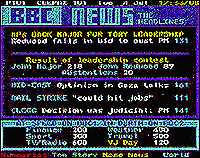![]() CEEFAX
CEEFAX
Britian's CEEFAX (phonetic for "See Facts") was the world's
first teletext system.
The foundation was laid at the British
Broadcasting Corp., and it may have been invented by anonymous technicians
at the BBC who used it to communicate among themselves at the various
transmitter sites around Great Britain, according to anecdotal data
collected by the author in Britain.
The first written mention of the possibility of
generating alphanumeric characters and the storage of one line of script
by electronic means comes in a note accompanying a memorandum on facsimile
dated Dec. 14, 1970, from P. Rainger, head of the designs department, to
the chief engineer, research and development  at
the BBC.
at
the BBC.
The note suggests that a "magazine" of
some 30 pages of information could be created, stored magnetically and
continuously updated.
The name "Teledata" was chosen and a
patent application entitled "The Transmission of Alphanumeric Data by
Television" was filed on Feb. 9, 1972 under the names of P. Rainger,
I. Miller and F. Parker.
Teledata was later renamed CEEFAX, which was
announced to the public on Oct. 23, 1972 and first demonstrated on Jan. 4,
1973.
On Jan. 13, 1976, CEEFAX, Oracle and the
forerunner of Prestel, called Viewdata, were displayed at a conference on
teletext. This was the first public appearance of Prestel.
After the Independent Broadcasting Authority
announced it would launch a competing teletext system called ORACLE and
the British Post Office announced its videotex system called Prestel, all
three negotiated a common protocol, which was adopted in March, 1974 and
entitled Broadcast Teletext Specifications.
The Ceefax system was well received throughout
the world and more than a dozen countries began testing, then operating,
teletext systems based on the model.
Ceefax still operates today on BBC channels 1 and
2 in the United Kingdom.